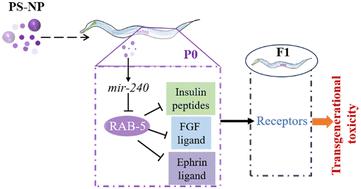当前位置:
X-MOL 学术
›
Environ. Sci.: Nano
›
论文详情
Our official English website, www.x-mol.net, welcomes your feedback! (Note: you will need to create a separate account there.)
Nanoplastic at environmentally relevant concentrations activates a germline mir-240-rab-5 signaling cascade to affect the secreted ligands associated with transgenerational toxicity induction in C. elegans
Environmental Science: Nano ( IF 5.8 ) Pub Date : 2024-07-02 , DOI: 10.1039/d4en00309h Xin Hua 1 , Le Zhang 1 , Dayong Wang 1, 2
Environmental Science: Nano ( IF 5.8 ) Pub Date : 2024-07-02 , DOI: 10.1039/d4en00309h Xin Hua 1 , Le Zhang 1 , Dayong Wang 1, 2
Affiliation

|
Epigenetic regulation plays an important role in regulating the transgenerational toxicity of pollutants. However, the underlying mechanism of microRNAs (miRNAs) in regulating transgenerational nanoplastic toxicity remains largely unclear. We aimed to determine the miRNA-mediated mechanism for the induction of transgenerational nanoplastic toxicity. In Caenorhabditis elegans, although germline RNAi of both mir-240 and mir-36 suppressed polystyrene nanoparticle (PS-NP) toxicity, exposure to PS-NPs (1–100 μg L−1) only increased mir-240 expression. A transgenerational increase in mir-240 expression was observed after PS-NP exposure at P0 generation (P0-G), and the germline RNAi of mir-240 suppressed transgenerational PS-NP toxicity. Among the predicted target genes of mir-240 in the germline, the exposure to PS-NPs (1–100 μg L−1) decreased rab-5 and rab-6.2 expressions, whereas the germline RNAi of mir-240 only increased rab-5 expression in PS-NP exposed nematodes. A transgenerational decrease in rab-5 expression was detected after PS-NP exposure at P0-G, and the germline RNAi of rab-5 strengthened transgenerational PS-NP toxicity. Moreover, the resistance of mir-240(RNAi) to transgenerational PS-NP toxicity in inhibiting locomotion behavior and in reducing the brood size was inhibited by the germline RNAi of rab-5. Among the secreted ligands, the germline RNAi of rab-5 increased the expressions of genes encoding insulin peptides (ins-3, ins-39, and daf-28), FGF ligand (egl-17), and ephrin ligand (efn-3) in PS-NP exposed nematodes and their corresponding receptor genes (daf-2, egl-15, and vab-1) in the offspring of PS-NP exposed nematodes. Therefore, an increase in germline mir-240 mediated transgenerational PS-NP toxicity through insulin, FGF, and ephrin signals by affecting its target RAB-5. Our data demonstrated the important involvement of germline microRNA in mediating nanoplastic toxicity across multiple generations in organisms.
中文翻译:

环境相关浓度的纳米塑料激活种系 mir-240-rab-5 信号级联,影响与秀丽隐杆线虫跨代毒性诱导相关的分泌配体
表观遗传调控在调节污染物的跨代毒性中发挥着重要作用。然而,microRNA (miRNA) 调节跨代纳米塑料毒性的潜在机制仍不清楚。我们的目的是确定 miRNA 介导的诱导跨代纳米塑料毒性的机制。在秀丽隐杆线虫中,尽管 mir-240 和 mir-36 的种系 RNAi 抑制了聚苯乙烯纳米颗粒 (PS-NP) 毒性,但暴露于 PS-NP (1–100 μg L −1 ) 仅增加了 mir-240表达。在 P0 代 (P0-G) 暴露于 PS-NP 后,观察到 mir-240 表达的跨代增加,并且 mir-240 的种系 RNAi 抑制了跨代 PS-NP 毒性。在种系中 mir-240 的预测靶基因中,暴露于 PS-NP(1–100 μg·L −1 )会降低 rab-5 和 rab-6.2 的表达,而 mir-240 的种系 RNAi 降低了 rab-5 和 rab-6.2 的表达。 240 仅增加暴露于 PS-NP 的线虫中 rab-5 的表达。在 P0-G 暴露 PS-NP 后,检测到 rab-5 表达的跨代下降,并且 rab-5 的种系 RNAi 增强了跨代 PS-NP 毒性。此外,mir-240(RNAi)对跨代PS-NP毒性的抵抗力(抑制运动行为和减少巢大小)受到rab-5种系RNAi的抑制。在分泌的配体中,rab-5的种系RNAi增加了编码胰岛素肽(ins-3、ins-39和daf-28)、FGF配体(egl-17)和肝配蛋白配体(efn-3)的基因的表达)在PS-NP暴露的线虫中及其相应的受体基因(daf-2、egl-15和vab-1)在PS-NP暴露的线虫的后代中。 因此,种系 mir-240 的增加通过影响其靶标 RAB-5,通过胰岛素、FGF 和肝配蛋白信号介导跨代 PS-NP 毒性。我们的数据证明了种系 microRNA 在介导生物体多代纳米塑料毒性中的重要作用。
更新日期:2024-07-02
中文翻译:

环境相关浓度的纳米塑料激活种系 mir-240-rab-5 信号级联,影响与秀丽隐杆线虫跨代毒性诱导相关的分泌配体
表观遗传调控在调节污染物的跨代毒性中发挥着重要作用。然而,microRNA (miRNA) 调节跨代纳米塑料毒性的潜在机制仍不清楚。我们的目的是确定 miRNA 介导的诱导跨代纳米塑料毒性的机制。在秀丽隐杆线虫中,尽管 mir-240 和 mir-36 的种系 RNAi 抑制了聚苯乙烯纳米颗粒 (PS-NP) 毒性,但暴露于 PS-NP (1–100 μg L −1 ) 仅增加了 mir-240表达。在 P0 代 (P0-G) 暴露于 PS-NP 后,观察到 mir-240 表达的跨代增加,并且 mir-240 的种系 RNAi 抑制了跨代 PS-NP 毒性。在种系中 mir-240 的预测靶基因中,暴露于 PS-NP(1–100 μg·L −1 )会降低 rab-5 和 rab-6.2 的表达,而 mir-240 的种系 RNAi 降低了 rab-5 和 rab-6.2 的表达。 240 仅增加暴露于 PS-NP 的线虫中 rab-5 的表达。在 P0-G 暴露 PS-NP 后,检测到 rab-5 表达的跨代下降,并且 rab-5 的种系 RNAi 增强了跨代 PS-NP 毒性。此外,mir-240(RNAi)对跨代PS-NP毒性的抵抗力(抑制运动行为和减少巢大小)受到rab-5种系RNAi的抑制。在分泌的配体中,rab-5的种系RNAi增加了编码胰岛素肽(ins-3、ins-39和daf-28)、FGF配体(egl-17)和肝配蛋白配体(efn-3)的基因的表达)在PS-NP暴露的线虫中及其相应的受体基因(daf-2、egl-15和vab-1)在PS-NP暴露的线虫的后代中。 因此,种系 mir-240 的增加通过影响其靶标 RAB-5,通过胰岛素、FGF 和肝配蛋白信号介导跨代 PS-NP 毒性。我们的数据证明了种系 microRNA 在介导生物体多代纳米塑料毒性中的重要作用。
















































 京公网安备 11010802027423号
京公网安备 11010802027423号